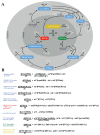An Inactivation Switch Enables Rhythms in a Neurospora Clock Model
- PMID: 31248072
- PMCID: PMC6627049
- DOI: 10.3390/ijms20122985
An Inactivation Switch Enables Rhythms in a Neurospora Clock Model
Abstract
Autonomous endogenous time-keeping is ubiquitous across many living organisms, known as the circadian clock when it has a period of about 24 h. Interestingly, the fundamental design principle with a network of interconnected negative and positive feedback loops is conserved through evolution, although the molecular components differ. Filamentous fungus Neurospora crassa is a well-established chrono-genetics model organism to investigate the underlying mechanisms. The core negative feedback loop of the clock of Neurospora is composed of the transcription activator White Collar Complex (WCC) (heterodimer of WC1 and WC2) and the inhibitory element called FFC complex, which is made of FRQ (Frequency protein), FRH (Frequency interacting RNA Helicase) and CK1a (Casein kinase 1a). While exploring their temporal dynamics, we investigate how limit cycle oscillations arise and how molecular switches support self-sustained rhythms. We develop a mathematical model of 10 variables with 26 parameters to understand the interactions and feedback among WC1 and FFC elements in nuclear and cytoplasmic compartments. We performed control and bifurcation analysis to show that our novel model produces robust oscillations with a wild-type period of 22.5 h. Our model reveals a switch between WC1-induced transcription and FFC-assisted inactivation of WC1. Using the new model, we also study the possible mechanisms of glucose compensation. A fairly simple model with just three nonlinearities helps to elucidate clock dynamics, revealing a mechanism of rhythms' production. The model can further be utilized to study entrainment and temperature compensation.
Keywords: Neurospora crassa; circadian clock; glucose compensation; mathematical modeling; molecular switch.
Conflict of interest statement
The authors declare no conflict of interest.
Figures













Similar articles
-
Phosphorylation, disorder, and phase separation govern the behavior of Frequency in the fungal circadian clock.Elife. 2024 Mar 25;12:RP90259. doi: 10.7554/eLife.90259. Elife. 2024. PMID: 38526948 Free PMC article.
-
Domains required for the interaction of the central negative element FRQ with its transcriptional activator WCC within the core circadian clock of Neurospora.J Biol Chem. 2023 Jul;299(7):104850. doi: 10.1016/j.jbc.2023.104850. Epub 2023 May 21. J Biol Chem. 2023. PMID: 37220856 Free PMC article.
-
The Neurospora circadian clock: simple or complex?Philos Trans R Soc Lond B Biol Sci. 2001 Nov 29;356(1415):1697-709. doi: 10.1098/rstb.2001.0968. Philos Trans R Soc Lond B Biol Sci. 2001. PMID: 11710976 Free PMC article. Review.
-
Structure of the frequency-interacting RNA helicase: a protein interaction hub for the circadian clock.EMBO J. 2016 Aug 1;35(15):1707-19. doi: 10.15252/embj.201694327. Epub 2016 Jun 23. EMBO J. 2016. PMID: 27340124 Free PMC article.
-
Posttranslational regulation of Neurospora circadian clock by CK1a-dependent phosphorylation.Cold Spring Harb Symp Quant Biol. 2007;72:177-83. doi: 10.1101/sqb.2007.72.025. Cold Spring Harb Symp Quant Biol. 2007. PMID: 18419275 Review.
Cited by
-
Nonlinear phenomena in models of the circadian clock.J R Soc Interface. 2020 Sep;17(170):20200556. doi: 10.1098/rsif.2020.0556. Epub 2020 Sep 30. J R Soc Interface. 2020. PMID: 32993432 Free PMC article.
-
Nutritional compensation of the circadian clock is a conserved process influenced by gene expression regulation and mRNA stability.PLoS Biol. 2023 Jan 5;21(1):e3001961. doi: 10.1371/journal.pbio.3001961. eCollection 2023 Jan. PLoS Biol. 2023. PMID: 36603054 Free PMC article.
-
Principles underlying the complex dynamics of temperature entrainment by a circadian clock.iScience. 2021 Oct 30;24(11):103370. doi: 10.1016/j.isci.2021.103370. eCollection 2021 Nov 19. iScience. 2021. PMID: 34816105 Free PMC article.
-
Evolution of the repression mechanisms in circadian clocks.Genome Biol. 2022 Jan 10;23(1):17. doi: 10.1186/s13059-021-02571-0. Genome Biol. 2022. PMID: 35012616 Free PMC article.
-
Syncytial Assembly Lines: Consequences of Multinucleate Cellular Compartments for Fungal Protein Synthesis.Results Probl Cell Differ. 2024;71:159-183. doi: 10.1007/978-3-031-37936-9_9. Results Probl Cell Differ. 2024. PMID: 37996678 Review.
References
-
- Wever R. Zum Mechanismus der biologischen 24-Stunden-Periodik. Kybernetik. 1963;2:214–231. - PubMed
-
- Dunlap J., Loros J., DeCoursey P. Chronobiology: Biological Timekeeping. Sinauer Associates; Sunderland, MA, USA: 2004.
-
- Vanselow K., Vanselow J.T., Westermark P.O., Reischl S., Maier B., Korte T., Herrmann A., Herzel H., Schlosser A., Kramer A. Differential effects of PER2 phosphorylation: Molecular basis for the human familial advanced sleep phase syndrome (FASPS) Genes Dev. 2006;20:2660–2672. doi: 10.1101/gad.397006. - DOI - PMC - PubMed
MeSH terms
Grants and funding
LinkOut - more resources
Full Text Sources

